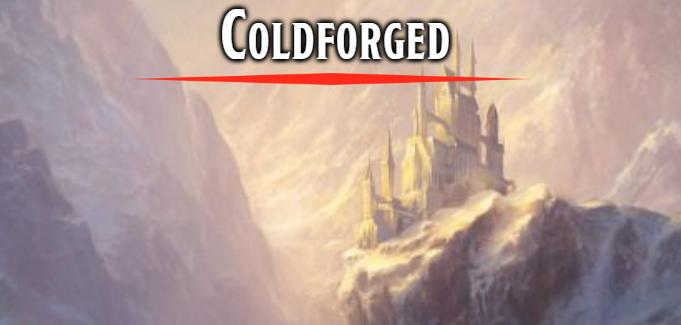
Coldforged Atlas: Political Geography
I continue rushing headlong into the second year of writing Coldforged material, and this year I hope to cover enough topics in preparation to print as is possible. I hope we’re in the home stretch. Here I’m continuing my atlas, turning from looking at the physical geography of the continent to the political geography of where they all live.
Settlements
No matter what culture or civilization that exists, it will always be the case that people will create towns, villages, and cities near the most important things: Food, trade routes, and resources. This maintains its truth no matter if those trade routes are through dense forests, the resources are in harsh and rocky foothills or if the food is grown best in mountain valleys.
Most settlements follow this basic procedure, and if you find a fertile valley or a river or a vein of gold, there is a strong chance that, nearby there is a town that claims it. The size of the settlement is often dictated by the value of the resource, and the cultures willingness and ability to extract it.
With all that, however, many cultures place a higher value on certain resources and locations, holding them to special significance either in culture, religion, ceremony, or another unique designation. These are the types of settlements that mark the culture as specific and different, and let you know that you are no longer within the familiar, and are in a place that sees the world very differently.
Killbarum
Killbarans, those descended from the Sepulchar Knights that defended Ravin’s tomb for centuries, have spread across the Imerian peninsula and the surrounding bay. Here, they live in neatly ordered towns and cities set up in the grid patterns that, for the most part, have remained true to the plans created by Heliachus in time immemorial.
Killbarans have always been a conquering people, and to that end, they have disproportionately built fortifications in strategic locations that were then used to conquer and control the previous inhabitants. These fortress towns have maintained garrisons of troops ready to lead retributive expeditions against the local populations since the Republic was young. Now, these many forts function both as independent actors and indicators the boundary of a strong warlords territory.
Tyndaria
The people of Tyndaria are a diverse group of individuals, of all races, nationalities, and kingdoms. It is here, in the center of the continent, that hubs of trade grew and then flourished. Eshkin, Elthrim, Occuran, Drimmen, Voskag, Levishan, Thraxian, and others all mingle together around the settlements that grew up around its plentiful natural resources, from iron and gold to stone and wheat.
Throughout the kingdom and its predecessor’s vital locations became the site of the immense and powerful symbol of the Central Tysis Kingdoms: The Castle. as the towns developed around these strong points, further and greater technological innovations were made to propel these edifices to the pinnacle of technology and power. They became commanding, near impervious structures, ministering the land and the settlements around it, amassing power as their subjects expanded into the great wilderness, building new towns and keeps and granting knighthoods and baronies.
Levisha
Though Levisha is ruled by elves as the nobility of the Fey, the rest of the creatures within the forest also exist side by side with the, in their immortal eyes, newcomers to their land. Centaur, sprite, satyr, and gnome all participate in the society that is left behind.
Unlike other kingdoms, the Levishans and the fey built their towns and cities not around resources, but around powerful natural wellsprings of power within the forest. Stone circles and altars were erected, groves sanctified and basins hallowed. Around these locations were built great halls, grown magnificent trees, and planted great gardens. The inhabitants of Levisha lived within nature as best as they could and took only what was needed in order to create majestic and powerful monuments to the power of the forest itself.
In contrast to the Levishans who have been able to cling to the trappings of society and culture, however, however, the wild and feral survivors of the Fey Plague roam the wilderness like a living plague themselves. These people have survived the ravages of the disease, including the complete loss of memory about who and what they were before infection. They find kinship with others who are also suffering from the loss and rage in having their former selves erased, and have bonded over their unwavering animosity towards those who live within the safety of towns and cities, knowing that they are never again going to be able to derive comfort from civilization. Their camps are ragged and makeshift things, with few amenities or desire for them, huts and tents thrown together without regard to order or hygiene, communal livestock, and shared resources. They often become restless and move on from the chosen locale, having exhausted what resources were there, desperately in need of more to sustain their ever-growing numbers, as the plague shows no sign of diminishing.
Thrax
The tribes of Thrax have occupied the forest they live in for hundreds of years, and allied themselves with the peoples who lived there before landed on the shores. A Thick and tangled place, the fight for resources is harder than most locations. Instead of finding what they need in easily accessible areas amid pleasant valleys and quiet plains, they are located behind barriers of stone and bramble, behind thickets of strong trees and within groves dominated by fierce land spirits.
The Thraxians have become adept at carving out locations within the forest that present themselves as possible locations large enough to hold a small population to individuals, no matter how rugged and difficult the terrain is. Remote glades, rocky valleys and dark lakes all have become the hallmark of a Thraxian town. Here, the Thraxian makes do, steadily clearing the harsh land, plowing under rocks and stones and hunting nearby dangerous wildlife. They make do with what they have access to.
That is not to say where resources exist naturally, there are no thraxian settlements. Instead, these settlements are limited in size by their location and surroundings, and those tribes who have access to rare and prized resources become the target of raids and attacks which in turn creates the need to be strongly defended, less someone conquers the vital resources.
Aldashir
The Aldashir, having been fled their homes within the Drimmak mountains, have very little choice on the resources available to them. Instead, they have been granted stay at Aldashir Citadel by King Wanderer and must make do with the lands around it, importing and trading for the rest.
That is not to say that the Aldashiri do not have any resources of their own. Within the massive fortress, there is a massive cistern and, thanks to a number of fungus farmers and breeders, now a huge swath of newly carved caverns for several varieties of mushrooms and fish. Additionally, there are a few small towns outside the walls, holding onto the land around the citadel itself, working the land and the single iron mine that is within the land, recently discovered by the excellent Drimmen prospectors. These towns are small and squat, often dug into hills and supported by the earth itself. The Drimmak of all sorts feel safer and more at home within the land than on it, and have built these towns to be nearly invisible, tunneling underground where possible and creating thoroughfares between houses and other locations maintained and supported by teams of expert engineers.
These few towns looks smaller than they are, with but a few necessary buildings above ground, and can easily be mistaken for a farmstead, but within its bounds live dozens of families ready to fight, if the need arises, to keep what little they have left.
Until Next time!


